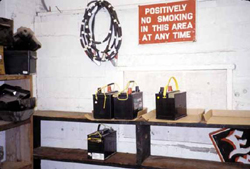New York Sea Grant's
Marina Pollution Prevention Web Site
Section 1: Mechanical Activities
-
Battery Replacement
Potential Environmental Impacts
If not handled properly, lead acid batteries pose certain hazards.
Battery components are toxic and corrosive, and can also be a
fire and explosion hazard. Lead and sulfuric acid can contaminate
the air, soil and water. Direct contact with sulfuric acid can
burn the skin and eyes. Exposure to lead in the environment can
pose a serious health hazard to children. Lead, which is also
very toxic to aquatic life, can be carried into the marina basin
by storm water runoff when spent lead acid batteries are not managed
properly. Lead released in the basin can contaminate the sediment
making dredging and disposal of the material very difficult and
costly.
Best Management Practices
- Avoid
long-term storage of lead acid batteries by sending accumulated
batteries to an authorized recycler within six months of receipt.
Limit accumulation of large quantities of spent batteries. If
necessary, ship more frequently.
- Store
spent lead acid batteries upright in a secure location, protected
from the elements, preferably
 indoors
in a space with an impermeable floor. Batteries stored outside
should be stored on an impermeable surface with secondary containment
and covered to prevent contact with rain or snow. indoors
in a space with an impermeable floor. Batteries stored outside
should be stored on an impermeable surface with secondary containment
and covered to prevent contact with rain or snow.
- Never
stack batteries directly on top of each other. Layer with wood.
- Never
drain batteries or crack the casings.
- Place
cracked or leaking batteries in a sturdy, acid-resistant, leak-proof,
sealed container (e.g., a sealable 5-gallon plastic pail). The
container should be kept closed within the battery storage area.
- Strap
batteries to pallets or wrap batteries and pallet in plastic during
transport.
- Keep
written records of weekly inspections of spent lead acid batteries.
Regulatory
Issues
- Spent lead
acid batteries must be recycled, and may not be disposed of with
other solid wastes.
- If you sell
lead acid batteries at your facility, you must accept a used lead
acid battery for each new battery that is sold to a customer.
Consumers that are not returning a used battery with the purchase
of a new battery must pay a five-dollar return incentive payment.
Retailers must post written notice informing consumers of these
requirements.
- There are
two options for managing spent lead acid batteries prior to sending
them for off-site reclamation. Batteries can be managed according
to the Universal Waste Rules (for Federal regulations [40 CFR
273] click
here; for New York regulations [6 NYCRR Subpart
374-3]
click here or, alternatively,
under special lead-acid battery recycling rules click
here in New York.)
- Universal
Waste Rule requirements. Marinas that store less than 5,000 kilograms
(11,000 pounds) of spent lead-acid batteries would be classified
as "Small Quantity Handlers" under these rules. Such
handlers are required to do the following [40 CFR 273 Subpart
B] click
here and [6 NYCRR Subpart 374-3] click
here.
- Mark
all batteries (or containers holding such batteries) with
the words "Universal Waste - Batteries," "Waste
Batteries," or "Used Batteries."
- Store
batteries for no more than one year before sending them off-site
for recycling.
- Place
any battery that shows signs of leakage, spillage, or damage
in a container that is kept closed, is structurally sound,
and is compatible with the contents of the battery.
- Immediately
contain any releases of batteries or electrolyte.
- Before
shipping batteries off-site, ensure that they are packaged,
marked, labeled, and placarded in accordance with U.S. DOT
rules for hazardous materials.
- Ship
the batteries to another Universal Waste handler, or to an
authorized destination facility for recycling. Prior to shipment,
ensure that the receiving facility agrees to receive the shipment.
Any shipments which are rejected must be taken back, or directed
to another handler or destination facility. In addition, if
you transport batteries from one site to another, you must
comply with Universal Waste transporter requirements [40
CFR 273 Subpart D] click
here.
- Lead acid
battery recycling rules. Persons managing their lead acid batteries
under this set of rules must do the following:
- Segregate
batteries from paper, rags, garbage, flammables, scrap metal
or hazardous chemicals by means of a berm, wall or other physical
barrier.
- Store
spent lead acid batteries on an impervious surface (such as
concrete sealed to protect the surface from degradation),
and inspect spent lead acid batteries weekly for leaks and
deterioration.
- Open,
handle or store spent lead acid batteries so that the battery
case does not rupture, leak, or produce short circuits.
- Although
the lead-acid battery recycling rules do not specifically
require it, before shipping batteries off-site, ensure that
they are packaged, marked, labeled, and placarded in accordance
with U.S. DOT rules for hazardous materials.
- Regardless
of which set of rules lead-acid batteries are managed under, a
hazardous waste determination must be conducted on spilled acid
and broken lead acid batteries, and any materials used to clean
a spill, to establish whether or not their disposal is subject
to hazardous waste regulations [40 CFR 262.11 click
here]. For more information on New York hazardous waste testing requirements, click
here.
- If over 500
pounds of batteries are stored onsite at your facility you must
report the chemicals in lead acid batteries (sulfuric acid and
lead) as part of your hazardous and toxic chemical inventory and
notifications required under the Emergency Planning and Community
Right-to-Know Act of 1986 (EPCRA) [40 CFR 355]. Click
here for more information on EPCRA requirements
.
|

